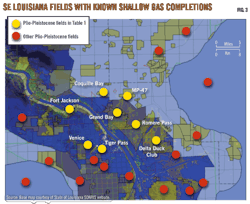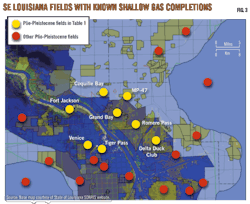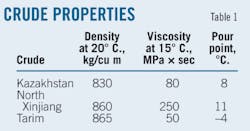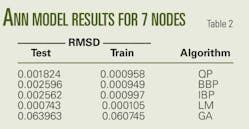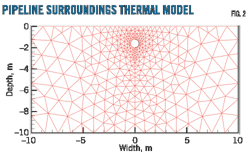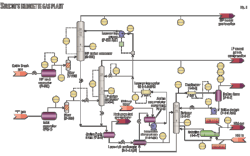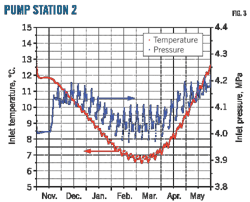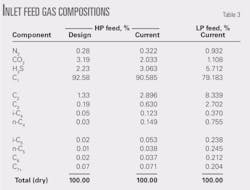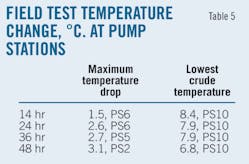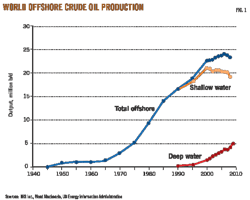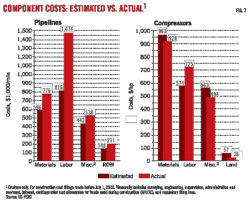Xin Liu
Jinjun Zhang
Hongying Li
Bo Yu
China University of Petroleum
Beijing
Intermittent operation in combination with pour-point depressants allows optimum long-term operation of low flow-rate, waxy crude pipelines.
The China West Crude Pipeline (610, 813, 711-mm OD, 1,838 km), runs between Urumqi, capital of the Xinjiang Uygur Autonomous Region, and Lanzhou, capital of Gansu province, northwest China (Fig. 1). It includes 12 pumping stations and a terminal.1 Soil temperature at buried depth ranges between 1° C. and 25° C. at different locations and times of the year.
The pipeline entered service in summer 2007 at about half its 422,810 b/d design capacity. Transported crude included imported Kazakhstan crude, crude produced in North Xinjiang oil field, and crude produced in Tarim oil field. Table 1 shows the properties of these crude oils.
Pour points of North Xinjiang and Kazakhstan crude measure 8° C. and 11° C., respectively, much higher than the soil temperature in the winter, prompting the use of pour point depressant (PPD) between November and May.1
Throughput fell to 25% of design capacity at the end of 2008 as a result of the global financial crisis, an extremely low flow rate for a large-diameter pipeline pumping waxy crude oil with pour points above ambient temperatures. This flow rate reduced the pumps' efficiency, but replacing them with smaller units would have been prohibitively expensive. The low flow rates combined with the possibility of operating temperatures falling below pour point also threatened the pipeline's safety.
After considering all possible measures to solve the problems of long-term low flow rate operation, China West Crude Pipeline settled on intermittent operation combined with PPD treatment. PPD treatment would minimize the risk of oil gelation at low temperatures.
Experimental and numerical studies—including rheological studies and pipelining simulation of the PPD-treated crude, as well as numerical simulation on the thermal and hydraulic states in the cyclic pumping and shutdown processes—tested the strategy before implementation. Field tests verified the accuracy of the experimental and numerical simulation results and reliability of the technology.
Laboratory experiment
Blending crudes before pumping ensured safe operations at low flow rates. Table 2 shows the pour points of the blended oils with different proportions of low-pour point Tarim crude. The blends are sensitive to heat and PPD treatment. Regardless of Tarim's proportion, heating the oil to 55° C. allows reduction of the pour point to less than –3° C. Adding 25 ppm PPD allows lowering pour point to –10° C.
Pump shear and pipe flow shear over long distances may deteriorate the flowability of PPD-treated crude, making it necessary to simulate transportation to test PPD effectiveness. Simulations used the quantitative simulation approach,2 applying different blends, different PPD doses (0 ppm, 25 ppm, and 50 ppm) and different ambient temperatures (soil temperatures of January, February, March, and April) and also measured pour points of the crude oil after various shutdown lengths.
The simulations yielded encouraging results in terms of both long-term dynamic stability of flow properties and static stability during shutdown (Table 3).
Numerical simulation
Intermittent operation of the waxy crude pipeline includes three discrete parts: normal operation, shutdown, and restart. The thermal and hydraulic dynamics of an intermittently operated pipeline are more complex than a continuously operated line.
Fig. 2 shows a thermal model. Equations 1 and 2 show the oil stream's heat transfer during normal operation and shutdown, respectively.3
Equation 3 shows heat conductivity of the wax deposition layer, pipeline wall, and corrosion protective coating.
Equation 4 shows heat conductivity of the soil, while Equation 5 is the flow equation of the restart process.
The Delaunay triangulation method generates meshes in selected computation regions (Fig. 2). The finite-volume method separates equations into polar and Cartesian coordinates, while the Gauss-Seidel method solves the equations.
Constrained by pump configuration, the minimum acceptable flow rate of the pipeline equals 1,000 cu m/hr, yielding an operation time-to-shutdown time ratio of about 2:1. Simulating different intermittent operation schemes (2-day operation/1-day shutdown, 4-day operation/2-day shutdown, and 6-day operation/3-day shutdown) allowed numerical analysis of oil temperature at the station inlet and hydraulic loss between each station.
Taking the 4-day operation/2-day shutdown scheme as an example, Fig. 3 shows the cyclic-operation induced periodic characteristics of inlet temperature and pressure between November and May. Inlet temperature decreases November to February and increases March to May, agreeing with the change trend of soil temperature.
The lowest oil temperature appears in March even though the lowest soil temperature appears in February, reflecting the lag in the heat capacity of the pipe as compared with the soil temperature. Pressure at the station inlet also changes periodically, most notably in February and March when the inlet temperature is lowest. Similar characteristics appear in 2-day operation/1-day shutdown and 6-day operation/3-day shutdown schemes.
Table 4 shows the lowest oil temperatures at the station inlet, with Cases 1, 2, and 3 representing intermittent operation Schemes 2-1, 4-2, and 6-3, respectively. The lowest temperature measured 4.8° C. even when the 6-day operation/3-day shutdown scheme was applied, meeting requirements that the lowest oil temperature remains above the pour point of the pumped crude.4
Figs. 4-5 show the results of a numerical simulation of restart after 72 hr of shutdown. The flow rate at the station inlet gradually increases at the initial stage of the restart process and stabilizes after reaching a peak value after 1 hr, reflecting the time it takes for the pressure wave propagating from the upstream station to reach the downstream station. Inlet temperature also rises as time elapses.
Field tests
Field tests conducted December 2008-January 2009, before industrial application, included 14-hr, 24-hr, 36-hr, and 48-hr of pipeline shutdowns. Even after 48 hr, the pipeline restarted without difficulty. Increased shutdown durations lowered oil temperatures. Maximum temperature drop reached 3.1° C. after the pipeline was shut down for 48 hr. The lowest temperature appeared at the inlet of PS10, consistent with it being the lowest soil temperature site (Table 5).
Figs. 6-7 compare the flow rate and temperature between the numerical simulation results and SCADA-recorded field data at the inlet of PS10 after a 36-hr shutdown. Flow rate and the inlet temperature gradually increased after restart. The small deviation between numerical simulation and field data further verified the software.
Analysis of field data shows the restart process would take 2-3 hr from switching on pumps at the first station to stabilization of the inlet flow rate at the last station. After successful field trials, the West Crude Pipeline selected intermittent operation of 7-day running/1-day shutdown schedule combined with PPD, overcoming the problems associated with operating the pipeline at a very low flow rate.
Acknowledgments
The National Science Foundation of China supported this project (No. 50944030 and No. 50876114).
References
1. Ling, X., Zhang, J.J., and Li, H.Y., "Transportation of waxy crude in batch through China West Crude Pipeline with pour-point-depressant beneficiation," International Pipeline Conference, Calgary, Sept. 29-Oct. 3, 2008.
2. Zhang, J.J., Zhang, F., Huang, Q.Y., and Yan, D.F., "Experimental simulation of effect of shear on rheological properties of beneficiated waxy crude oils," Journal of Central South University of Technology, Vol. 14, Supplement 1, pp. 108-11, 2007.
3. Xu, C., Yu, B., Zhang, Z.W., Zhang, J.J., Wei, J.J., and Sun, S.Y., "Numerical simulation of a buried hot crude oil pipeline during shutdown," Petroleum Science, Vol. 7, No. 1, pp. 73-82, 2010.
4. SY/T 5536-2004, The Operation Regulation of Crude Oil Pipeline, Chinese standard, 2004.
The authors
More Oil & Gas Journal Current Issue Articles
More Oil & Gas Journal Archives Issue Articles
View Oil and Gas Articles on PennEnergy.com
